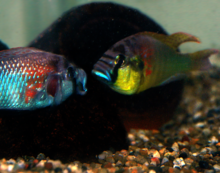Astatotilapia burtoni
| Astatotilapia burtoni | |
|---|---|
 |
|
| Two males dispute a territorial boundary | |
| Scientific classification | |
| Kingdom: | Animalia |
| Phylum: | Chordata |
| Class: | Actinopterygii |
| Order: | Perciformes |
| Family: | Cichlidae |
| Subfamily: | Pseudocrenilabrinae |
| Tribe: | Haplochromini |
| Genus: | Astatotilapia |
| Species: | A. burtoni |
| Binomial name | |
|
Astatotilapia burtoni (Günther, 1894) |
|
| Synonyms | |
|
|
Astatotilapia burtoni is a species of fish in the Cichlidae family.
It is found in Burundi, Rwanda, Tanzania, and Zambia.
Its natural habitats are rivers, intermittent rivers, swamps, freshwater lakes, freshwater marshes, intermittent freshwater marshes, and inland deltas.
Astatotilapia burtoni has been used as a model organism to study the behaviors and physical systems of cichlids, including their development and embryogenesis. Moreover, the phylogenetic position of this particular species makes it an ideal model system for comparative genomic research. A. burtoni belongs under the haplochromines, which is the lineage of cichlids with the most species, and has been discovered to be a sister group to both the Lake Victoria region superflock (which has about 600 species) and the species flock of Lake Malawi (which has about 1,000 species).
The males of the Astatotilapia burtoni come in two phenotypes that are reversible. The males can readily switch between being territorial and non-territorial based on the social environment they are in: dominant, territorial males possess bright coloration, aggressive behavior while defending territory, and an active role in sexually reproducing with the females; on the other hand, subordinate and non-territorial males possess coloration similar that of the females, lack initiative to pursue female counterparts, and are reproductively suppressed due to regressed gonads. The transitions between different social roles cause several changes in the brain and reproductive system, such that the social transformation affects them both behaviorally and physically.
To expand on reversibility, if a territorial male is placed with an individual that is significantly larger in size, it will then rapidly socially transform into the non-territorial type. This change can be detected by the behavior and alternate coloration that follows. The change in reproductive competence, however, occurs about three weeks after the formerly territorial male loses its territory to the larger fish. In regards to the other social transition, when a non-territorial male becomes the territorial type, it will almost immediately exhibit aggressive behavior and an eyebar, while the physiological changes will follow in about one week.
...
Wikipedia

